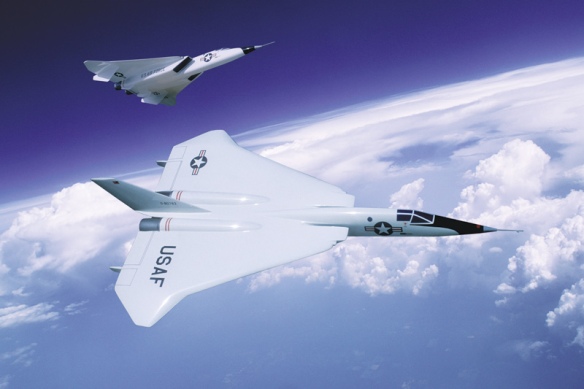Rendering of a notional U.S. Air Force F-108A interceptor. The big North American Aviation aircraft was intended to intercept Soviet bombers at long range. Artists conception by Erik Simonsen
The North American F-108 Rapier was designed in 1957 as a modified-delta, twin-engined two-seat fighter larger by far than any previous fighter ever built. Its two crewmen were to wear pressure suits and ride inside individual ejection capsules. In 1959, two B-58 Hustler bombers were allocated to Hughes Aircraft for development of the ANIASG-18 fire-control system for the nuclear-tipped GAR-9 (AIM-47A) air-to-air missile intended for the F-108. The F-108 was apparently seen as both a long-range polar interceptor and an escort for the company’s very similar and only slightly- larger XB-70 Valkyrie bomber.
The F-108 was in part a direct reaction to the appearance of the Soviet Union’s Myasishchev Mya-4 “Bison” bomber at the May 1955 Tushino air show in Moscow. The U.S. air attache telephoned Washington to report that the Soviets had enormous numbers of the new bomber. In fact, the Soviet were simply flying the same three airplanes around in circles and having them appear repeatedly over the audience. To counter this threat, ADC would need an interceptor that could travel far from U.S. cities and engage attacking bombers in the distant north.
By January 1959, North American had completed a full-scale mock-up of the F-108, which would have been capable of intercepting a bomber 1,000 miles from its target. The finished aircraft would be ready for a first flight in March 1961 and would join ADC squadrons in July 1963. The F-108 was to supplant the shorter-legged F-106 Delta Dart by operating autonomously far beyond the limits of the existing SAGE (Semi-Automatic Ground Environment) air intercept system. The F-108 would carry three big GAR-9 Falcon missiles, later called AIM-47s, on a rotary launcher in an internal weapons bay. The GAR-9 missile was to be powered by a Lockheed storable liquid-propellant rocket motor capable of driving the missile to hypersonic speeds of up to Mach 6 and out to a range of 115 miles. The Rapier (the popular name assigned officially on March 15, 1959) was to employ a large and complex air-to-air AN/ASG-18 radar system developed by Hughes.
The F-108 design featured a large “cranked” delta wing (the wing size and shape was redesigned several times) and two afterburning General Electric J93-GE-3AR turbojets engines, the same powerplants that would later appear on North American’s XB-70 Valkyrie bomber. The big interceptor was designed with a pilot and radar operator seated in tandem in individual ejection capsules, and was intended to have a maximum speed of Mach 3 at altitude (1980 miles per hour at 75,550 feet).
But the price tag of the F-108 kept going up.
More importantly, U.S. officials soon learned that the Soviets were giving top priority to intercontinental ballistic missiles – bypassing the bomber as a strategic nuclear weapon. Very belatedly, U.S. experts learned that only 34 “Bisons” were built and that they lacked true intercontinental reach; other Soviet bombers were produced in small numbers only.
Mostly because of cost and perhaps only serendipitously because the Soviets didn’t have a large bomber force, the Pentagon abruptly canceled the F-108 Rapier project on Sept. 23, 1959.
The work on the Rapier was not wasted. The work Hughes did on the radar was later transferred over to the Lockheed F-12 interceptor, a derivative of the SR-71 Blackbird, and when the F-12 was cancelled, the radar evolved into the AWG-9 later carried by the Grumman F-14 Tomcat. Likewise, if the F-12 had become operational, it would have used the version of the Falcon missile intended for the “might have been” F-108 Rapier, which also become the base from which the AIM-54 Phoenix was developed. The Phoenix became the Tomcat’s principle armament, and so the U.S. Navy became the principal beneficiary of the Air Force’s investment.
Specifications (XF-108)
General characteristics
Crew: two
Length: 89.2 ft (27.2 m)
Wingspan: 57.4 ft (17.5 m)
Height: 22.1 ft (6.7 m)
Wing area: 1,865 ft² (173.4 m²)
Empty weight: 50,907 lb (23,098 kg)
Max. takeoff weight: 102,000 lb (46,508 kg)
Powerplant: 2 × General Electric YJ93-GE-3AR afterburning turbojet
Dry thrust: 20,900 lbf (93.0 kN) each
Thrust with afterburner: 29,300 lbf (130.3 kN) each
Performance
Maximum speed: Mach 3+, 1,980 mph (1,720 kn, 3,190 km/h)
Range: 1,271 mi (1,104 nmi, 2,033 km) combat
Ferry range: 2,488 mi (2,162 nmi, 4,004 km)
Service ceiling: 80,100 ft (24,400 m)
Wing loading: 55.9 lb/ft² (183.4 kg/m²)
Thrust/weight: 0.56
Armament
Guns: 4 x 20 mm cannon
Missiles: 3 × Hughes GAR-9A air-to-air missiles in a rotary weapons bay
Bombs: 4,000 lbs
